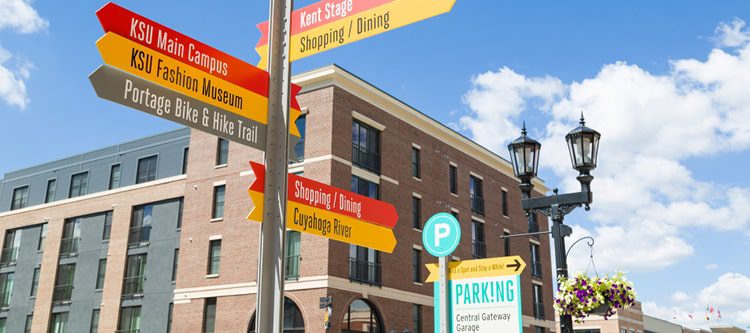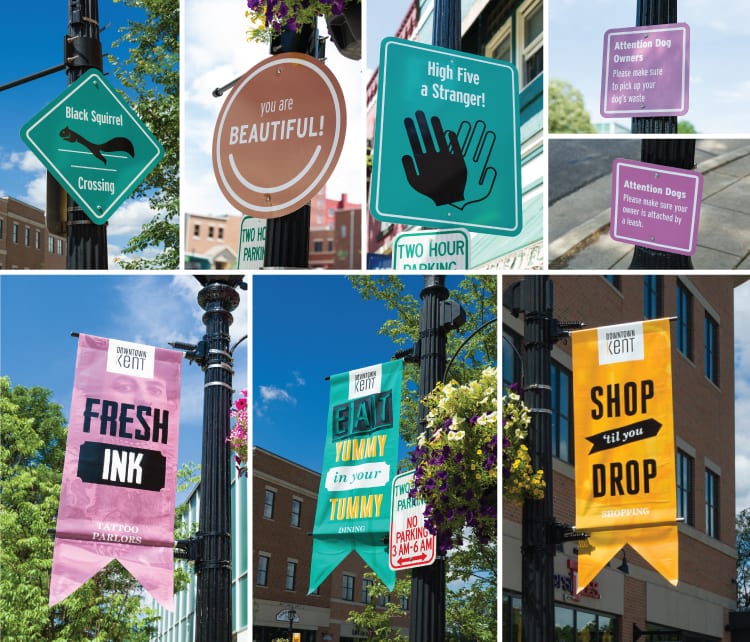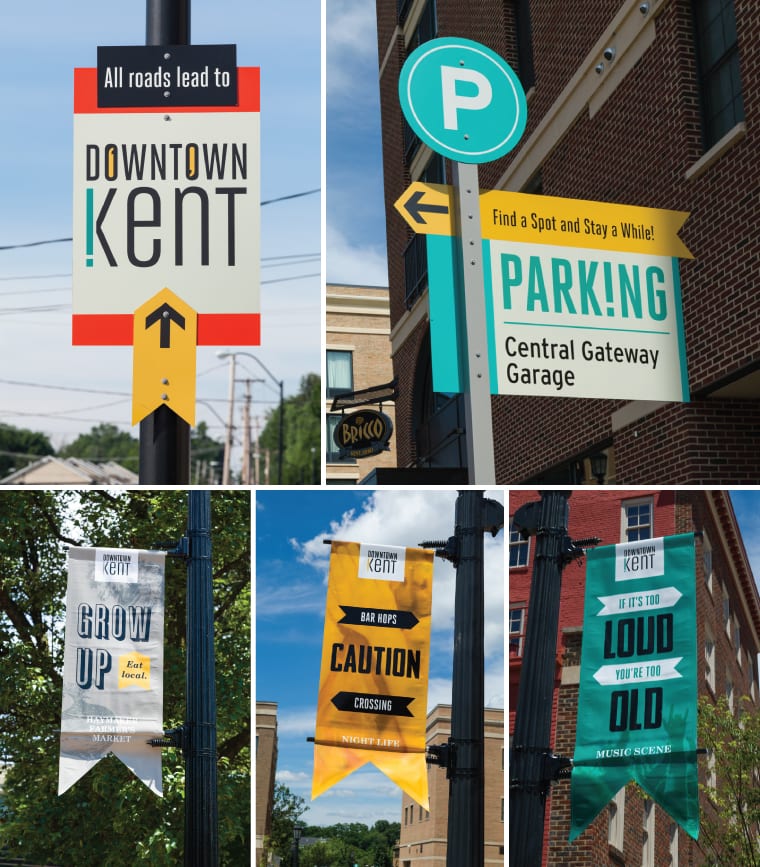
Signage is commonly used to get people from Point A to Point B. It’s necessary and purposeful, and the information gets the job done as long as the information is correct. But if your image and reputation rely on people having a good time and feeling comfortable, safe, and confident in navigating through a new place — it’s not just about moving people from point A to point B; it’s about improving experiences. Beyond helping people not get lost, signage and wayfinding should be inspired and more connected to a community’s brand, giving people a sense of place and reinforcing its unique personality.
Don’t get us wrong – wayfinding programs should prioritize telling people where they are and helping them get where they want to go. We all know what can happen when signage systems fail – we miss flights, zoom past our exits, are late to appointments, and spend time irritably pacing up and down streets looking for our destination. But while some believe its sole purpose is to provide directions, we believe the best wayfinding strategies transcend navigation to instill a stronger sense of place. This article will uncover what can support more profound discovery, exploration, and engagement by aligning your place branding and wayfinding strategies.
Let’s be clear.
First, let’s get something straightened out. Just as many people assume a brand is a logo, some places confuse the design of a new wayfinding system as being their brand. Yes, the two disciplines are connected, but they are not one and the same.
Your brand is the summation of everything that makes your place what it is and differentiates you from your competition. It’s your story, your people, your culture, your visual identity, and your messaging. For example, a university’s brand answers, “Why should I choose you?” When students decide to visit the campus, they expect a particular experience based on everything you’ve communicated thus far. Upon their arrival, any uncertainty about where they are or difficulties in finding parking, essential facilities, and nearby accommodations will make them question their decision and your brand. This is precisely where wayfinding comes into play.
Wayfinding connects various verbal and visual elements of a physical environment, including space, maps, directions, architecture, landscape design, symbols, colors, and logos, to remove ambiguity around where they are. When visitors are happy and well-oriented, they are likely to spend more money, plan return visits and sing your praises to their family and friends, boosting your image, experience, and reputation.
Let your image and personality shine.
Messaging on signage will always take priority; after all, signage has a job to do. It tells people when they have arrived, where to exit, and directs you to all you can see and do. When incorporating your brand into a signage and wayfinding program, you provide an added communication level. In addition to its basic functionality, branded wayfinding can introduce personality, storytelling, and opportunities to capture the moment, contributing to deeper relationships between your place and your audiences. One of Guide Studio’s mantras is that we use brand and design to solve issues and meet objectives — this means that even if a formal visual identity is not in place, we can use your historical, physical, cultural, and social features and translate that into how we determine design styles, material selection, and location context to express the uniqueness of your place.

A Case in Point: The City of Kent had recently completed a large-scale redevelopment in their downtown. It changed the context of the place and the experience offering more shopping, dining, and entertainment opportunities. They initially wanted to help visitors find the city’s parking lots and garages more easily. It was a practical goal, but they soon realized they had an opportunity to do more to engage people in everything the city had to offer.
“We wanted to instill a sense of ‘you have arrived’ when people walked or drove around the city,” said James Bowling, Superintendent of Engineering/Deputy Service Director at the City of Kent. “To do that, we needed to strengthen the connection between all of our amenities – accessible parking, restaurants and shops, historical buildings, fun nightlife, and nearby Kent State University. Simply putting up signs near parking wouldn’t cut it.”

Guide Studio channeled the Downtown’s brand essence when designing the new signage and wayfinding program, tying everything together under a common theme that embraces the city’s unique history and personality. Quirky messaging and colorfully designed banners promote downtown’s greatest assets. The design team also took advantage of underutilized street poles and incorporated playful signs that set the tone for the personality and atmosphere of the downtown.
“Some of the messaging is completely unexpected, like the signs for dogs, but it adds an element of surprise, giving people a reason to stop and appreciate the environment we’ve created,” said Bowling. “We’ve always had a welcoming atmosphere and lots of things to do, but now our wayfinding accentuates our best qualities.”
Use your space to tell your story.
Wayfinding is not just signage, and signage isn’t just wayfinding. When considering ways to incorporate your image and personality into the experience you offer, it helps to take a more holistic approach. Multiple touchpoints exist throughout your environment, including points of entry, crosswalks, building facades, sidewalks, light poles, etc. How can you enhance these elements to support a more brand-aligned experience?
Beyond infusing humor and quirkiness into their signs, the City of Kent wanted to honor the town’s history through its wayfinding system. They worked with the Kent Historical Society to put together stories that were placed on the backs of pedestrian kiosks.
“We used one side of the kiosks for maps and the other to highlight significant moments and people that have shaped who we are,” said Bowling. “I wouldn’t normally think to use the back of a sign or kiosk, but I see people reading them all the time, which tells me that we’ve made walking from one destination to another an experience.”
Many businesses and communities have found creative ways to convey their brand throughout their physical environments. If you’re in the market for new furniture, take a trip to the nearest IKEA and notice how their unique signage system directs you to different sections of the store and reinforces their budget- and family-friendly brand through icons and fun messaging. Cities have used elements of their story, personality, or brand in their sidewalks, crosswalks, and walls to communicate who they are, where they are, and where they can go. And if you’re a baseball fan, visit Cleveland’s Progressive Field to see how the stadium’s recent renovations are emphasized through a new, comprehensive wayfinding system that evokes the city’s industrial history and team spirit.
Just be yourself
We live in an age when people have become highly sensitive to user experience. Websites and mobile applications have introduced us to sophisticated navigation, layouts, and imagery, making us all self-proclaimed design aficionados. As a result, our expectations for our physical environments are even more heightened, leaving little room for sub-par design and poor navigational support.
While that may sound a little intimidating, synthesizing your brand and wayfinding should be a creative exercise of just being yourself. Not only is that one of life’s most important lessons, but places can, and should, reflect the history, people, aesthetics, stories, and personality for which they are known. What’s the fun of looking like everyone else when you can stand out from the crowd? Giving visitors the opportunity to get to know the real, authentic side of your place will make them appreciate you even more.
Featured Post
Sorry, we couldn't find any posts. Please try a different search.